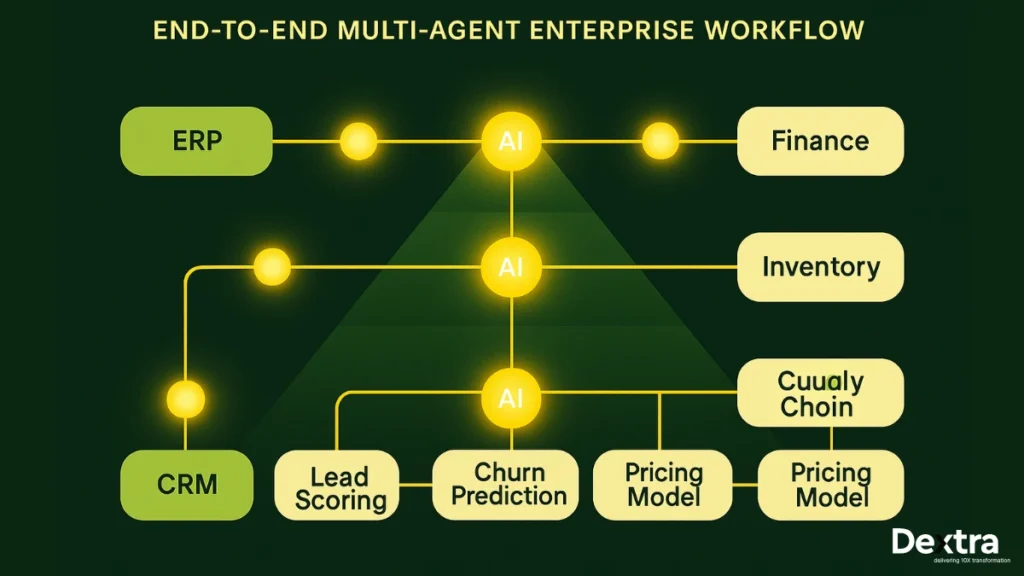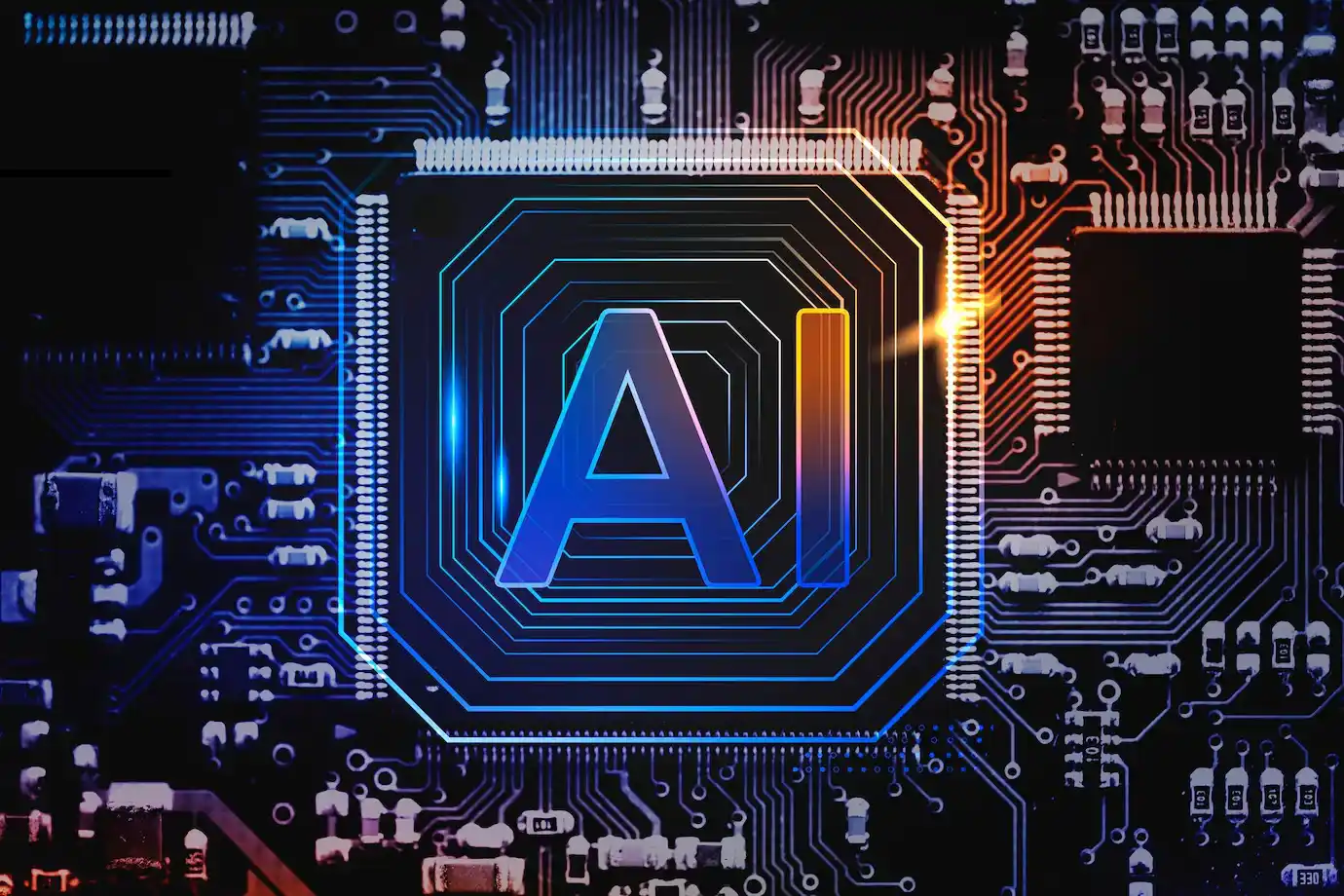The enterprise AI landscape has transitioned into another phase. The early deployment of AI copilots that help employees with simple task-based prompts has evolved into advanced multi-agent workflows that can accomplish complex business operations across ERP, CRM, and analytics systems. They are no longer assistants – they are becoming digital co-workers.
In 2025, enterprises across the USA, UK, UAE, India, and Singapore are moving beyond prompt-driven tools like ChatGPT and GitHub Copilot to agentic AI systems that manage entire departments’ worth of operational workflows.
In a recent survey conducted by McKinsey & Company, 88% of organisations indicate there is now regular use of AI in at least one business function (78% a year ago). Also, 23% of respondents say their organisations are scaling ‘agentic AI’ systems in at least one function.
From the perspective of Dextralabs, the future of enterprise AI is orchestrated intelligence—a world where multiple autonomous agents work safely together across a unified ecosystem. This shift is changing the way organisations think about automation, shifting away from human-led decision-making to AI-assisted orchestration that enables efficiency, scalability, and innovation.
For leaders exploring AI consulting companies in USA, AI transformation consulting in UK, or Enterprise AI in Dubai, this shift marks the next leap toward smarter, safer, and more connected business environments.
From Copilots to Co-Workers: What’s Changing?

The difference between co-pilots and co-workers indicates the maturity of enterprise AI.
- Co-pilot: A single-task AI assistant that aids an individual in a specific task — like drafting code, generating reports, or analysing data.
- Co-worker: A network of AI agents that autonomously work alongside humans and systems to complete workflows from beginning to end.
Previously, the role of a co-pilot was to increase human productivity. Today, multi-agent workflows are optimising the entire enterprise ecosystem. The dynamic has changed from human-driven processes to AI-assisted orchestration — where humans set the goals, and AI agents plan, coordinate, and execute.
Dextra Labs describes this transformation through its AI Orchestration Pyramid:
- Copilot Stage: Task-based assistance with restricted context.
- Multi-Agent Coordination: Multiple agents working on related tasks.
- Autonomous Orchestration: Agents working together across various departments.
- Self-Adaptive AI Ecosystem: Systems that learn, adapt, and manage themselves with minimal human effort.
As AI consulting companies in USA and AI consulting firms in Dubai continue to spur innovation, this path—from copilots to co-workers—is becoming the norm for enterprise automation at scale. According to a 2025 PwC survey, 79% of businesses indicate that they are implementing AI agents, and 88 % plan to increase their AI-related budgets in the next 12 months.
Also Read: Why Your AI Strategy Isn’t Delivering ROI (And How to Fix It)
Enterprise Orchestration Use Cases: ERP, CRM, and Beyond
The biggest impact of multi-agent orchestration can be seen in core enterprise systems, like ERP and CRM. With ERP AI integration and CRM AI orchestration, organizations are modernizing operations and achieving higher ROI.

ERP AI Integration
In conventional ERP systems, siloed data between finance, inventory, and the supply chain modules often leads to inefficiencies. Today, (large language model) LLM agents serve as autonomous intermediaries that automatically reconcile data across modules, forecast demand, and optimize inventory.
CRM AI Orchestration
Customer engagement is also seeing significant changes. Through workflow automation AI, multi-agent systems analyze customer journeys, predict churn, and personalize engagement without human intervention. A CRM AI orchestration might contain lead-scoring agents, sentiment-analysis bots, and pricing optimizers working cooperatively to improve conversion rates.
Finance, HR, and Operations
In finance, AI agents can automate reconciliation and approval workflows. In HR, AI agents advance talent acquisition through screening, onboarding, and training orchestration.
Dextralabs Insight:
In 2025, over 60 % of enterprise AI workloads will involve orchestration and firing messaging across different systems — marking a fundamental shift from isolated copilots to collaborative co-workers.
For LLM deployment consulting in India and AI consulting firms in Dubai, these are capabilities that are enhancing competitive and operational excellence across manufacturing, retail, fintech, and logistics sectors.
How Multi-Agent Orchestration Works?
At the heart of this transformation is an intelligent AI orchestration framework — the backbone that coordinates how multiple AI agents interact, collaborate, and execute tasks.
Each agent in this architecture has a specialised domain role — such as finance, compliance, or marketing. These agents communicate through shared APIs and retrieval-augmented generation (RAG) pipelines, ensuring decisions are contextually aware and auditable.
A central orchestrator manages priorities, workflow dependencies, and human oversight. This ensures smooth collaboration between systems like SAP, Salesforce, and Oracle, while maintaining governance standards. According to IBM, the shift to “AI orchestrators” that govern networks of agents is expected to become a backbone of enterprise systems in 2025.
Key components of the architecture include:
- Agent Communication Bus: Real-time data sharing and decision-making.
- LLM Orchestration Layer: The layer where large language model (LLM) reasoning provides intelligence.
- Observability Dashboards: A method for real-time monitoring of agent actions and performance metrics.
The AI orchestration framework provided by Dextralabs provides scalability and security so that enterprises in London, Dubai, and Singapore can implement Agentic AI systems with complete transparency.
This approach helps support organisations in accomplishing something competitive, AI consulting firms in USA, and AI governance consulting in Singapore describe as a “safe autonomy at scale.”
Also Read: The Agentic AI Maturity Model 2025
Governance, Safety, and Permissions
As organizations begin to deploy Agentic AI systems, governance and safety must be prioritized as fundamental pillars of success. The power of autonomous agents must be balanced with compliance, auditability, and ethical responsibility.
Dextralabs prioritizes AI safety for enterprises by integrating these governance projects directly into the orchestration layer. Governance includes:
- Role-based permissions: Clearly define who or what each agent can access.
- Guardrails for data access: Place safeguards around sensitive data.
- Observability and audit logs: Provide visibility around and tracking of each AI decision from start to finish.
- Compliance with global statutes: Including GDPR, SOC 2, and EU AI Act.
For example, a retailer was able to achieve 100% auditability by using an AI‐permission layer from Dextralabs within their ERP workflows.
Governance-first approaches are critical to organizations in regulated markets like Enterprise AI Dubai, AI transformation consulting in UK, and Enterprise AI stack in Southeast Asia — enabling audit and compliance without slowing down innovation.
Metrics That Matter: Measuring AI Co-Worker Success
For AI co-workers to make a real impact within an enterprise, it is important to have a set of distinct measurement areas that measure both performance and impact. Dextralabs assists organizations in evaluating orchestration maturity through measurable KPIs that combine operational efficiencies, governance, and ROI.
Operating KPIs
- Time-to-completion of workflows
- Automation ratio of the task
- Error percentage reduction
Financial KPIs
- Cost effectiveness
- ROI uplift
- Productivity growth
Governance KPIs
- Compliance ratios
- Audit success score
- Safety incident decrease
“We identify orchestration maturity across six dimensions — autonomy, collaboration, safety, scalability, observability, and ROI.” – CTO (Dextra Labs)
These data-driven frameworks are essential for AI consulting companies in USA, AI strategy for startups in India, and Agentic AI solutions in London to validate enterprise automation investments.
Challenges in Multi-Agent Orchestration (How to Solve Them)
Despite the possibilities, multi-agent orchestration (MAO) presents several challenges. In response, Dextralabs is identifying and solving these challenges with AI design and governance initiatives.
Common Challenges:
- Context Fragmentation: Information is siloed among systems.
- Overlapping Agent Roles: Redundant or conflicting decision-making logic.
- Lack of Action Traceability: Ambiguity about agent actions.
- Hallucination or Misalignment: Agents reach inaccurate conclusions.
Dextralabs’ Responses:
- Context Fusion Pipelines: An amalgamation of data sources to achieve a base understanding.
- Dynamic Agent Role Allocation: An adjustment of roles based on workload or contextual variables as needed.
- Observability Dashboards: Deliver visibility in real time and reporting.
- Safety Layers and Governance APIs: Confirm to comply with frameworks.
Furthermore, according to Digital Commerce 360, while agentic AI is increasing rapidly, only 34 % of organisations reported the adoption of agentic systems at scale that required investment in agentic AI. By embedding AI safety for enterprises into every deployment, Dextralabs reduces risk while accelerating innovation, marking itself as one of the best AI consulting firms in Dubai and AI orchestration consulting companies globally.
Dextralabs’ Approach: A Safe and Scalable Multi-Agent Framework
Dextralabs has developed an Agentic AI framework for enterprises wanting to operationalise AI co-workers, which is modular, scalable, and secure. It enables safe orchestration across ERP, CRM, and analytics systems, with both cloud-agnostic scalability and compliant first design.
The Core Pillars of Dextralabs’ Multi-Agent Orchestration Framework:
- Modular Orchestration Design: Our flexible architecture grows with the enterprise.
- Continuous Observability: Real-time measures of performance and risk.
- Governance Integration: Built-in safety and compliance operationalisation.
- Cloud-Agnostic Scalability: Deployable in AWS, Azure, or GCP environments.
Dextralabs has a vast experience in diverse markets, from enterprise AI adoption in USA, to LLM deployment consulting in India, and AI consulting companies in Dubai. Here are a few of their client success stories:
- ERP orchestration assistance for a global retailer in the UAE
- CRM automation for a financial enterprise in London, UK
- Compliance-driven automation for an IT firm in Singapore
This multi-regional success proves why Dextralabs is one of the leading AI consulting companies in USA, for organisations creating the next generation of intelligent enterprise systems.
Future Outlook: The 2025–2026 AI Co-Worker Landscape
As companies get closer to 2026, the role of AI will shift from a productive machine service model to a collaborative intelligence in which humans and machines co-create innovation, experience, and value.
Predicted Trends:
- Human-AI Decision-Making Collaboration: AI co-workers providing contextual recommendations while humans validate critical choices.
- Context-Learning Automation: Agents that learn from the real world continuously.
- Workflow Governance: Safety, auditability, and compliance are becoming default features.
According to Reuters, experts predict that by 2028, 15% of routine business decisions will be made autonomously by agentic AI – a scale which is effectively 0% in 2024.
For leaders who are considering AI governance consulting in Singapore, AI transformation consulting in UK, or AI strategy for startups in India, now is the time to create the frameworks that will support long-lasting innovation.
Dextralabs’ CEO summarization: “The enterprises that effectively master and safely orchestrate AI today will constitute the workforce of AI tomorrow.”
Conclusion
The copilot period is coming to an end—it’s the advent of AI co-workers.
If your organization is ready to move beyond task automation to intelligent, autonomous collaborations, Dextralabs can help.
As a trusted partner among leading AI consulting companies in USA, AI transformation consulting in UK, and AI consulting firms in Dubai, Dextralabs offers proven frameworks to accelerate the enterprise’s path for automation.
Book a consultation today to discuss your enterprise AI roadmap and see how multi-agent deployment services can transform your operations in 2025 and beyond.
Evolving from copilots to co-workers?
Dextralabs enables enterprises to design, deploy, and govern multi-agent orchestration systems across ERP and CRM — safely, efficiently, and at scale.
Talk to Our ExpertsFAQs:
Q. Is it legal to use Copilot or AI assistants at work?
Yes, using tools like Copilot or ChatGPT at work is generally legal.
The real concern isn’t legality, it’s governance:
– Does your company allow AI tools?
– Are you handling sensitive or client data safely?
– Are outputs being reviewed before use?
Most enterprises now permit AI with guidelines, especially in regulated industries. When in doubt: check your internal AI policy or ask IT/security.
Q. How do you actually use Copilot or AI assistants effectively?
Think of copilots as “task helpers,” not decision-makers.
They work best when you give them:
– Clear instructions
– Good context
– Examples of the output you want
– A final human review
They’re great for drafting, summarizing, analyzing text, or prepping data — but they are not multi-agent orchestrators. That’s the next stage.
Q. Can humans and AI really collaborate?
Absolutely and that’s where enterprise AI is heading.
Collaboration today looks like:
– Humans defining goals
– AI agents planning steps
– Systems executing workflows
– Humans validating critical decisions
It’s less “AI replacing people” and more AI co-workers helping teams move faster with fewer errors.
Q. What exactly is enterprise automation software?
Enterprise automation software helps companies remove repetitive manual work across systems like ERP, CRM, HR, finance, and operations. Traditionally it meant RPA or workflows.
In 2025, it now includes:
– AI copilots
– Multi-agent systems
– Autonomous orchestration
– AI-driven decision engines
The shift is from “automating tasks” to automating business logic and entire workflows.
Q. What are the four main types of automation?
Most organizations categorize automation into four layers:
1. Task Automation – Small, rule-based tasks
2. Process Automation – Multi-step workflows
3. Intelligent Automation – AI-enhanced decisions
4. Autonomous Orchestration – Agents coordinating across systems (the newest layer)
Modern AI co-worker systems operate at layers 3 and 4.
Q. What’s the difference between IPA and RPA?
RPA (Robotic Process Automation)
– Clicks buttons, fills fields, follows strict rules
– Works well for predictable tasks
– Breaks when a screen changes
IPA (Intelligent Process Automation)
– Uses AI + ML + LLM agents
– Handles exceptions and context
– Learns patterns and adapts
– Orchestrates across systems
RPA copies human clicks.
IPA behaves more like a digital analyst.
Q. What are ERP integrations in an AI-driven world?
ERP integrations let your ERP (SAP, Oracle, Dynamics) talk to other systems:
– CRM
– Finance apps
– Data warehouses
– Supply chain systems
In AI-driven orchestration, integrations are no longer just data pipes — they become interaction layers where AI agents coordinate workflows across modules automatically.
Q. Can AI replace ERP systems?
Not anytime soon. But AI is redefining how ERP works:
– Automating reconciliation
– Predicting demand
– Cleaning master data
– Coordinating cross-module workflows
– Providing natural language access to ERP logic
ERP is becoming the “system of record,” while AI becomes the “system of intelligence” layered on top.
Q. Is there an AI specifically built for ERP?
Yes. Companies now use:
– LLM agents for finance
– Inventory optimization agents
– Supply chain orchestration agents
– Compliance-checking agents
Instead of customizing ERP endlessly, AI agents now handle logic and decisions externally — creating a flexible, adaptive ERP experience.
Q. What does ERP mean in the context of AI?
In AI-first enterprises, ERP becomes:
Enterprise Resource Planning enhanced by autonomous decision-making.
AI interprets data, predicts trends, and triggers actions inside ERP systems without human intervention.
ERP = system of record
AI = system of reasoning
Together, they form a self-optimizing operational layer.
Q. What is an example of agent orchestration?
Imagine this workflow:
1. A sales agent flags a high-value lead in CRM
2. A finance agent checks credit risk
3. A pricing agent recommends a tailored offer
4. A supply chain agent verifies inventory
5. An orchestrator agent sends the proposal
No humans coordinated any of this — AI co-workers did.
This is agent orchestration in action.
Q. What is multi-model orchestration?
Multi-model orchestration means using multiple AI models or agents simultaneously, such as:
– LLMs for reasoning
– Vision models for document reading
– Predictive models for forecasting
– RAG pipelines for knowledge
The orchestrator determines which model does what and in which order.
Q. What does “orchestration” mean in AI?
Orchestration is the ability to:
– Assign tasks to the right AI agents
– Coordinate steps across systems
– Manage dependencies
– Maintain safety and governance
– Trigger outputs automatically
It’s the difference between “a single assistant” and an intelligent, coordinated digital workforce.
Q. What is MAS in AI?
MAS = Multi-Agent System.
It’s a system where multiple autonomous AI agents:
– Communicate
– Collaborate
– Negotiate
– Share context
– Execute complex workflows
Think of MAS as AI teams working like human teams — just faster, safer, and at scale.





